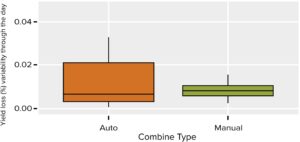Loss range wider for auto-adjust combines
PAMI ran an on-farm survey of combine grain loss in canola in 2019, reporting that temperature, relative humidity and weather conditions had a significant impact on the 1.3 bu./ac. losses (2.8 per cent of total yield) out the back of the combine. More specifically, lower temperatures (below 23°C), higher relative humidity (above 45 per cent) and cloudy weather were associated with significantly higher combine losses.
However, canola’s relatively small seed weight compared to material other than grain during threshing makes setting a combine for canola more challenging than large-seed crops, like corn.
To minimize losses, project outcomes suggested adjusting any combination of fan speed, rotor/cylinder speed, concave clearance, sieve openings and ground speed of the combine. To ensure each adjustment is effective, losses need to be checked (manually and/or with the yield loss monitors) after each change. This requires a bit of time and effort – at a crunch time in the season.
Building on that study
Further examining this topic, PAMI’s 2022 “Quantifying combine auto-adjusting capabilities in canola” study investigated the impact of weather conditions throughout a harvest day and the methods used to adjust combine settings to minimize losses. The research included 22 combines representing four brands and 14 different models – half of the combines had auto-adjusting capabilities and half were manual adjusting.
Researchers evaluated combine losses from straight cut (14 fields) and swathed canola (eight fields) from 13 growers throughout Saskatchewan and Manitoba. PAMI researchers used drop pans to take samples (three repetitions) at three times throughout the day. They did not provide this data to farmers during the testing.

Findings:
- Average combine losses ranged from 0.1 bu./ac.
to 10.6 bu./ac. - As average daily temperatures increased, yield loss variation increased significantly. But variation of temperature and humidity throughout the day did not significantly impact the variability of percentage yield loss throughout the day.
- Researchers observed no significant difference between losses in: swathed and straight cut operations, different ground speeds tested, or calendar date (ranging from September 9 to October 10).
- Interestingly, while there was no significant difference between losses in auto-adjusting and manual-adjusting capabilities, there was much less variation in the losses for the manual adjusting combine types than the auto-adjusting types.
This indicates that checking for losses is important and auto-adjusting combines still need calibration and monitoring to ensure that they are properly responding to changing conditions. Overall, you need to know what is happening to make informed management decisions and any method of checking for losses is better than not checking at all.





